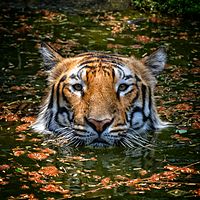
Photo from wikipedia
Abstract Restoration to increase resilience to current and projected drought and fire in historically open-canopy forests in fire-prone environments may be constrained by concern for species that favor dense forest… Click to show full abstract
Abstract Restoration to increase resilience to current and projected drought and fire in historically open-canopy forests in fire-prone environments may be constrained by concern for species that favor dense forest conditions. To assist the recovery of a threatened species, the Northern Spotted Owl (NSO), in dry forest environments, the US Fish & Wildlife Service (USFWS) recommends embedding NSO conservation and recovery in restoration efforts that enable ecosystem recovery from past management actions and increase resilience to changing climate. In this study, we assessed changes between historical and current (1) forest structure and composition and (2) extent of NSO nesting and roosting (NR) or foraging (F) forest cover on 39,000 ha at the eastern edge of the current designation of the range of the NSO. Historical records depict a predominantly open-canopy landscape dominated by large ponderosa pine. Current conditions include more than a 600% increase in trees 15–53 cm dbh, substantial decline in trees ⩾81 cm dbh, loss of the widespread distribution of trees ⩾53 cm dbh, and loss of the dominance of ponderosa pine on mixed conifer sites. NSO habitat assessment involves a suite of attributes including: landscape context; species composition; canopy cover; basal area; average tree diameter; diameter diversity; and abundance of large trees, snags, canopy layers, coarse woody debris, and mistletoe. We tested for the presence of forest that met USFWS threshold values for two of these variables, canopy cover and basal area. Historically none of the area met the 60% canopy cover threshold for NR or F forest cover and almost none meets it currently. However, several NSO nesting pairs and individual birds have been observed in the study area over the last 20 years, and studies in other frequent-fire forests show that canopy cover as low as 50% may be functional for NSO. To assess the implications of lower threshold values, we tested for NR or F forest cover presence at half the recommended thresholds, considerably below published estimates. Only five percent of the area exceeded 30% canopy cover historically; much of the current forest exceeds it today. Increase in canopy cover comes at the expense of increasing vulnerability to fire and drought and loss of historical functions and processes. Conflicting objectives of forest restoration and maintenance of spotted owl habitat on this site – isolated habitat in the dry margin of the range of the NSO – raises questions about how to achieve forest restoration in altered landscapes where existing, novel conditions favor at-risk species.
Journal Title: Forest Ecology and Management
Year Published: 2017
Link to full text (if available)
Share on Social Media: Sign Up to like & get
recommendations!